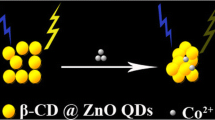Abstract
Multicolor and water-soluble CdTe quantum dots (QDs) were synthesized with thioglycolic acid (TGA) as stabilizer. These QDs have a good size distribution, display high fluorescence quantum yield, and can be applied to the ultrasensitive detection of Pb(II) ion by virtue of their quenching effect. The size of the QDs exerts a strong effect on sensitivity, and quenching of luminescence is most effective for the smallest particles. The quenching mechanism is discussed. Fairly selective detection was accomplished by utilizing QDs with a diameter of 1.6 nm which resulted in a detection limit of 4.7 nmol L−1 concentration of Pb(II). The method was successfully applied to the determination of Pb(II) in spinach and citrus leaves, and the results are in good agreement with those obtained with atomic absorption spectrometry.

Five colors water-soluble CdTe QDs are synthesized with thioglycolic acid as a stabilizer. These QDs can be applied to the ultrasensitive detection of Pb2+ by virtue of their quenching effect. The size of the QDs exerts a strong effect on sensitivity, and the quenching of luminescence is most effective when the smallest particles are used. The detection limit is 4.7 nmol L−1 when QDs-I (1.6 nm) are used, which is the lowest in the current related study.






Similar content being viewed by others
References
Maria AGT, Elvira MGL (2008) Toxic effects of perinatal lead exposure on the brain of rats: Involvement of oxidative stress and the beneficial role of antioxidants. Food Chem Toxicol 46(6):2089–2095
Maren L, Jantje F, Franziska L, Corinna T, Martin S (2009) Chronic toxic demyelination in the central nervous system leads to axonal damage despite remyelination. Neurosci Lett 453(2):120–125
Pan YH, Liu XS, He XQ, Wang CH (2005) Lead speciation analysis by high performance liquid chromatography-inductively coupled plasma mass spectrometry. Chin J Anal Chem 33(11):1560–1564
Zacharia A, Gucer S, Izgi B, Chebotarev A, Karaaslan H (2007) Direct atomic absorption spectrometry determination of tin, lead, cadmium and zinc in high-purity graphite with flame furnace atomizer. Talanta 72(2):825–830
Hsieh HF, Chang WS, Hsieh YK, Wang CF (2009) Lead determination in whole blood by laser ablation coupled with inductively coupled plasma mass spectrometry. Talanta 79:183–188
Pharmacopoeia C (2005 edition)
Baranowska I, Barchanska H, Pacak E (2006) Procedures of trophic chain samples preparation for determination of triazines by HPLC and metals by ICP-AES methods. Environ Pollut 143(2):206–211
Tian JN, Liu RJ, Zhao YC, Xu Q, Zhao SL (2009) Controllable synthesis and cell-imaging studies on CdTe quantum dots together capped by glutathione and thioglycolic acid. J Colloid Interface Sci 336:504–509
Jr MB, Moronne M, Gin P, Weiss S, Alivisatos AP (1998) Semiconductor nanocrystals as fluorescent biological labels. Science 281:2013–2016
Chan WCW, Nie SM (1998) Quantum dot bioconjugates for ultrasensitive nonisotopic detection. Science 281:2016–2018
Han MY, Gao XH, Su JZ, Nie SM (2001) Quantum-dot-tagged microbeads for multiplexed optical coding of biomolecules. Nature 19:631–635
Li Z, Dong CQ, Tang LC, Zhu X, Chen HJ, Ren JC (2010) Aqueous synthesis of CdTe/CdS/ZnS quantum dots and their optical and chemical properties. Luminesc. doi:10.1002/bio.1250
Yan ZY, Pang DW, Shao XF, Hu YZ (2005) Determination of trace amount of copper in the chinese herbal medicine by fluorescence quenching of quantum dots. J Chin Pharm Univ 36(3):230–233
Gattás-Asfura KM, Leblanc RM (2003) Peptide-coated cds quantum dots for the optical detection of copper(II) and silver(I). Chem Comm 2684–2685
Zhang YY, Dong J, Wang N, Gao P, Zang SL (2009) The synthesis of luminescent CdTe quantum dots and its interaction with Au(III). Anal Sci 25(2):135–138
Pendyala NB, Koteswara Rao KSR (2009) Efficient hg and ag ion detection with luminescent PbS quantum dots grown in poly vinyl alcohol and capped with mercaptoethanol. Colloid Surf A 339:43–47
Zhong WY, Liang JR, Yu JS (2009) Systematic study of the interaction of cobalt ions with different-sized CdTe quantum dots. Spectrochim Acta Part A 74(3):603–606
Wang C, Zhao JW, Wang Y, Lou N, Ma Q, Su XG (2009) Sensitive Hg (II) ion detection by fluorescent multilayer films fabricated with quantum dots. Sensors Actuator B Chem 139(2):476–482
Wu P, Li Y, Yan X (2009) Cdte quantum dots (QDs) based kinetic discrimination of Fe2+ and Fe3+, and CdTe QDs-fenton hybrid system for sensitive photoluminescent detection of Fe2+. Anal Chem 81(15):6252–6257
Mayra GV, Arístides CVG, Josefa AGC, Marta ED (2009) Analytical nanotechnology for food analysis. Microchim Acta 166:1–19
Wu HM, Liang JG, Han H (2008) A novel method for the determination of Pb2+ based on the quenching of the fluorescence of CdTe quantum dots. Microchim Acta 161:81–86
GB/T 5009.12-1996
Yu WW, Qu L, Guo W, Peng X (2003) Experimental determination of the extinction coefficient of CdTe, CdSe, and CdS nanocrystals. Chem Mater 15(14):2854–2860
Demas JN, Crosby GA (1971) The measurement of photoluminescence quantum yields. J Phys Chem 75(8):991
Burda C, Chen X, Narayanan R, El-Sayed MA (2005) The chemistry and properties of nanocrystals of different shapes. Chem Rev 105(4):1025–1102
Xia YS, Cao C, Zhu CQ (2008) Two distinct photoluminescence responses of CdTe quantum dots to Ag (I). J Luminesc 128(1):166–172
Scaiano JC, Laferriere M, Galian RE, Maurel V, Billone P (2006) Non-linear effects in the quenching of fluorescent semiconductor nanoparticles by paramagnetic species. Phys Stat Sol (A) 203(6):1337–1343
Lai SJ, Chang XJ, Fu C (2009) Cadmium sulfide quantum dots modified by chitosan as fluorescence probe for copper (II) ion determination. Microchim Acta 165:39–44
Isarov A, Chrysochoos J (1997) Optical and photochemical properties of nonstoichiometric cadmium sulfide nanoparticles: surface modification with copper(II) ions, vol 13. American Chemical Society, Washington, DC, ETATS-UNIS
Acknowledgement
This work was financially supported by the National Natural Science Foundation of China (No. 20975050) and Jiangsu Province Program of Top-level Talents.
Author information
Authors and Affiliations
Corresponding author
Electronic supplementary material
Below is the link to the electronic supplementary material.
ESM 1
(DOC 210 kb)
Rights and permissions
About this article
Cite this article
Zhong, W., Zhang, C., Gao, Q. et al. Highly sensitive detection of lead(II) ion using multicolor CdTe quantum dots. Microchim Acta 176, 101–107 (2012). https://doi.org/10.1007/s00604-011-0695-z
Received:
Accepted:
Published:
Issue Date:
DOI: https://doi.org/10.1007/s00604-011-0695-z




